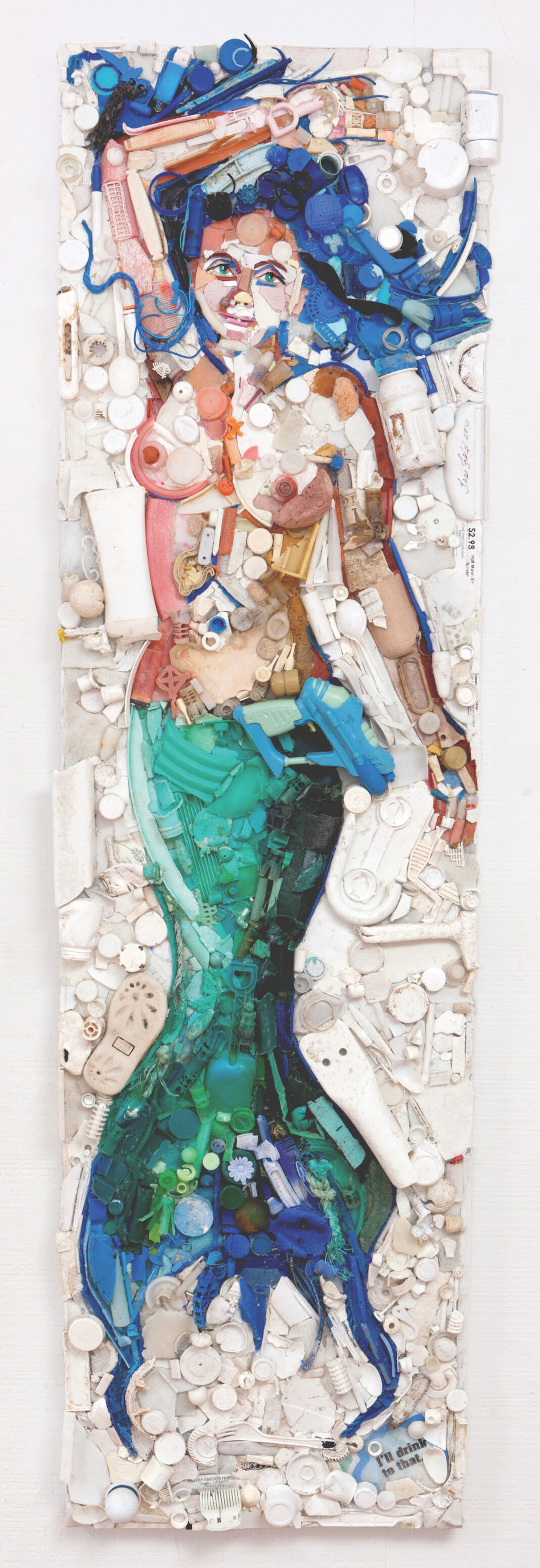It was the fall of 2020, and I was on the phone with longtime Stinson Beach resident and celebrated environmental artist Tess Felix. Our conversation ranged from her creative endeavors to the immediate context—the upcoming presidential election, the most critical in American history; the cost of living, or not, in a place like Marin for her children’s generation; and the fires. It was during the pandemic, before the vaccine. The long breath we held before the votes. And in the thick of it, one artist shared—as she had for many years—what she saw. Her lens is at once unique and ubiquitous: Plastic trash.
When we picked up in recent weeks, I wondered: Had the long-planned Malta exhibition happened? With a laugh, Felix replied, “No.” Americans still can’t visit the island nation on account of Covid-19. She was supposed to lead a plastic-Jesus billboard project to wryly encourage the Maltese to waste less plastic. The Book of Mormon in San Francisco was obviously abandoned, but what about her show at the de Young Museum, the one that was slated, then canceled, then rescheduled, then canceled? Also a “No.”
So, like many seeking ways to grapple with the twin forces of a preventable pandemic and economic collapse, Felix turned her focus to home. Though she has always loved exploring the human experience with her hands—she’s a highly sought-after costume and theatrical craftsperson in addition to a working fine artist—she found new solace in gardening at her seaside home in Stinson, where she’s lived with her family for three decades. “I’ve kept that up,” she said with a chuckle. “Me too,” I replied. The orchard I planted with my family last year is on the verge of bearing a shocking amount of fruit this year—well, all right, the orchard planting I stage-directed.
During much of the California lockdowns, West Marin drew more people who wanted to be closer to the beach and to be able to get outside, and issues with everything from water to parking were notoriously difficult to manage for local residents. “The message was, ‘don’t come,’” Felix said. “But what are you going to do, if you’re stuck in a small apartment? People need to be able to get out and enjoy the fresh, natural air. But hundreds of people would come to the park or the beach, and there’s no parking and no bathroom usage—it was really a challenge.”
In a very real way, Felix has always expressed herself at home, connecting our shared global urgency of climate change with the beaches of her environment. In this sense, Felix is not really an environmental artist so much as an artist reflecting our collective choices back at us.
It all began one day when Felix took one of her daily beach strolls. “I began to notice all the trash,” she told me. “It was just everywhere.” Plastic: It’s not just a patch in the Pacific. It defines our existence, and Felix finds that unacceptable.
It is important to make a distinction: Felix did not come to her work as an environmental activist, and still does not consider herself one, though her art is obviously centered on messages of waste and ocean conservation. Her career has included fascinating nomadic stints, from studying the arts and crafts in London to working on Hollywood film sets. But the work that resulted from that day on the beach has become her hallmark over the past decade.
She simply began collecting the waste: Doll parts. Broken toys. Bottle caps and pen caps. Beads and bits. Décor-turned-to-detritus. Over time, she gathered so much refuse from Stinson Beach she had to sort the items by color in bins in her home. Her pieces are assemblages of the plastic pieces, always depicting a face looking back at the viewer. “I’m fascinated by faces; not as a critique, but as an observer,” she said.
The works take considerable time to build. They are vivid and disconcerting, with unflinching, yet not hostile, gazes. One early work, which garnered significant critical attention, features colorful, life-size mermaids. They are sensual, yet carry an edge: They’re armed with plastic toy guns, which one could imagine they’ve filched, like so much treasure, from a sunken ship. They are themselves plastic waste. They carry, and represent, collected and collective pain.
In the years since, Felix’s works have been featured in dozens of exhibitions and galleries, from the U.S. to China and beyond. She also does commissioned work, often large in scale. Earlier collages are tight and intricately arranged. As her work has evolved, the collages have become more organic, even a bit “loose,” according to Felix. If the first works are emotionally charged in their precision, subsequent pieces are more vulnerable.
For we are more vulnerable. I’m struck by how little has really changed since this time last year, from an environmental standpoint. So, in spite of Felix’s work in several instances being put on hold, I am inspired by how she continues to explore new forms of expression. She was recently featured in an award-winning short film series, Every Second Breath, an ocean preservation project. And, when she wasn’t working on private commissions and digging in the soil during the pandemic, she challenged herself to paint—for the first time in many years—with the added requirement of painting faces upside down. Our exclusive cover depicts another fearless effort, a self-portrait Felix notes is not especially flattering because of the foreshortened angle, but one that makes a more interesting perspective. The artist is looking.
For more about Tess Felix: www.artworksforchange.org/portfolio/tess-felix/








